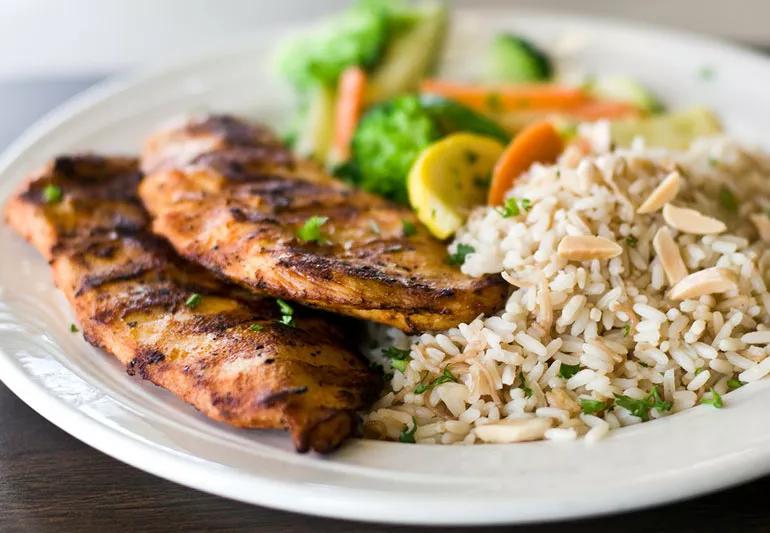Pesticides, fertilizers in soil contain some arsenic

By: Laura Jeffers, MEd, RD, LD
Advertisement
Cleveland Clinic is a non-profit academic medical center. Advertising on our site helps support our mission. We do not endorse non-Cleveland Clinic products or services. Policy
Every year, we hear one or two reports about too-high-to-be-safe levels of something in our food supply. In many cases, the danger is limited to a specific geographic region, but sometimes it’s a problem that affects the entire nation.
The Food & Drug Administration (FDA) reported in 2012 that there’s too much arsenic in two things many of us eat frequently – rice and chicken. The levels were too low to be deemed an official threat, but the presence of arsenic in food is always a concern.
Arsenic is a metallic mineral from the Earth’s crust that is released into the soil and water via fertilizers and pesticides. Organic forms are less toxic than inorganic forms. Regardless of its form, the question is whether you can feel safe eating foods that have even low arsenic levels.
You might not know it, but you likely eat more than 20 pounds of rice every year. It might be sushi, rice pudding, rice milk, or just rice that’s part of a comfort-food dinner. This white or brown grain holds a traditional place at our dinner table, but it also absorbs inorganic arsenic more easily than other foods we typically eat.
Regular exposure to arsenic, even at low levels, can slightly raise your risk of bladder, lung and skin cancer, as well as heart disease and Type-2 diabetes. It can also have a negative impact on a baby’s growing immune system.
Advertisement
Recent studies evaluated arsenic in our rice supply and found most of it is, fortunately, organic. Levels have risen in recent years, but they’re still not high enough for the FDA to be concerned. That said, there’s still no federal limit for the levels of arsenic in our rice supply.
Eat less rice. If you’re worried, I suggest eating only half of the daily recommended rice intake and adding more variety to the grains you eat.
Rinse your rice. The U.S. Rice Foundation advises rinsing raw rice before cooking and using a 1-to-6 cup rice-to-water ratio, draining the excess water off after cooking.
Know which types of white rice are considered safest. Overall, white basmati rice from California, India and Pakistan, as well as U.S. sushi rice, has half the level of inorganic arsenic as other rice types. However, all rice – except sushi and quick-cooking – from Arkansas, Texas, Louisiana and most other U.S. locations had the highest inorganic arsenic levels.
Limit kids’ consumption of drinks with rice. Rice-containing beverages have among the highest inorganic arsenic levels, so they should be given sparingly to children younger than age 5.
Choose your brown rice carefully. Although brown rice has more nutrients than white rice, studies found brown rice has roughly 80% more inorganic arsenic. Brown basmati from California, India and Pakistan are the best options, having one-third less arsenic than other kinds of brown rice.
Try other grains. There are gluten-free and gluten-containing grains that have almost no inorganic arsenic, according to the U.S. Rice Foundation. For example, you could add amaranth, buckwheat, millet and polenta (or grits) to your diet, as well as bulgur, barley and farro.
But, arsenic in rice doesn’t just affect the grain. It makes its way to your dinner plate in another way – through the chicken that eats the rice as feed.
Arsenic was introduced to chicken feed in the 1940s as a way to improve muscle growth, fight disease and make the meat pinker. Most of the arsenic is excreted, but some ends up in the chicken meat.
In 2014, the FDA called for the removal of the animal drug Roxarsone from chicken feed, saying it can transform into inorganic arsenic. But, removing it from the market is an ongoing process.
Eliminating Roxarsone from chicken feed could have a significant impact on our health in the United States. According to a 2006 Institute for Agriculture and Trade Policy report, annual chicken consumption per American sky-rocketed 250 percent between 1965 and 2013, jumping from 33.7 pounds to 83.1 pounds. The same report also revealed that 70% of the 8.7 million chickens bred for the food supply ate feed containing Roxarsone.
Advertisement
In the meantime, if the low levels of arsenic in chicken still make you nervous, you can choose other sources of protein, including fish, beans and tofu.
However, I don’t recommend removing chicken from your diet. I eat it regularly and will continue to do so as a part of a balanced and varied diet.
Advertisement
Learn more about our editorial process.
Advertisement

Washing your hands, thoroughly cleaning kitchen tools and preparing meat separately can reduce the risk of foodborne illness

Extended outages lasting more than four hours can make food in your fridge unsafe to eat

Microwaves use non-ionizing radiation and haven’t been shown to cause cancer — follow food safety practices and use microwave-safe containers

Once perishable food hits the table, it’s typically good for about two hours

Color, texture, smell and expiration date all hold important clues

No! Be sure to put your leftovers in the fridge

Don’t let any turkey or stuffing go to waste this year!

Not all processed foods are bad, but the fewer the ingredients, the better

If you’re feeling short of breath, sleep can be tough — propping yourself up or sleeping on your side may help

If you fear the unknown or find yourself needing reassurance often, you may identify with this attachment style

If you’re looking to boost your gut health, it’s better to get fiber from whole foods